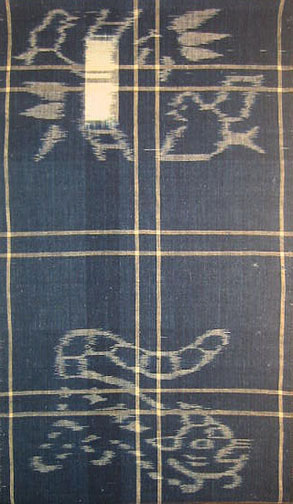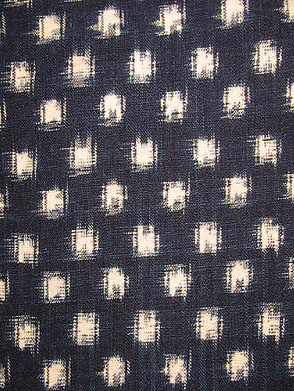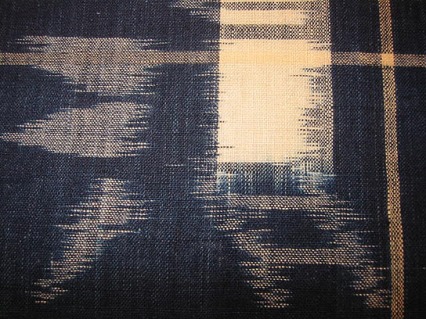This week’s featured weave, the wedding blanket of which a detail is shown above, was handwoven by Berber women in the mountains of Morocco. (I should perhaps mention that Berbers — who call themselves “Imazigen,” which means “free people” in the Berber language — are indigenous people who have lived in North Africa for 4,000 years.) This was another gift from my friend Penelope, who traveled to the Fès-Meknès area and brought back some fascinating textiles. Wedding blankets are believed to have magical powers that protect the users from the evil eye, so this would have been an especially welcome gift. (Click this link to read an earlier post about another Moroccan textile from Penelope’s trip. That fabric’s silk fiber content is suddenly in doubt after a reader posted interesting information about it.)
My blanket is 3’7″ x 5’8″, and is very warm to sleep under. It is densely woven plain weave, in natural-colored sheep’s wool, with lighter-colored nubby cotton stripes and smooth cotton knotted pile fringe. Round metal sequins, like the ones visible in the photos, are traditionally sewn on by brides-t0-be and their relatives.
In his excellent book The Techniques of Rug Weaving, Peter Collingwood says, ” A clove hitch on one or two warp ends, is used in some Moroccan rugs.” My blanket’s fringe has four multi-strand knots per inch, as shown in the photo above. I can’t tell whether the clove hitch is the knot that was used or not, but maybe I can find out at the October 31 meeting of the New York Guild of Handweavers, when Susan S. Davis, an anthropologist and expert on Moroccan textiles, will be the guest speaker. For complete information about the meeting (the public is welcome), visit the Guild’s website, here, and to read more about Susan S. Davis and about her work with Moroccan women rug weavers, visit her website, here.
One of the reasons that I love writing my blog is that it leads me to look closely at textiles that I have lived with, and taken for granted, for years, so that I can write about them. Knotted pile, for example, is a technique that I tried once and discarded because it wasn’t practical for production weaving (the result was the vegetable-dyed pillow to the right of Bobby in the photo below).
However, examining the wedding blanket has reawakened my interest in the pile weaves, and I’m excited about where the concept may take me. Don’t look for shaggy scarves at Saks any time soon, though.
Update: To see three more Berber wedding blanket capes, see Susan S. Davis’s photo on my gallery page (click on the thumbnail to enlarge the image).









